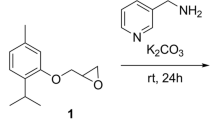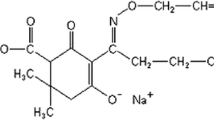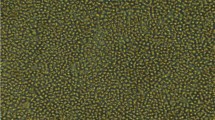Abstract
Helichrysum Mill. (Asteraceae) species have been used in folk medicine for thousands of years in the world. The in vitro cytogenetic effects in human lymphocytes of nine Helichrysum taxa used in Turkey folk medicine were investigated. Blood samples were obtained from healthy donors, non-smoking volunteers, which were incubated and exposed to increasing concentrations of methanol extracts of Helichrysum taxa (0.01, 0.05, 0.1, 0.5 and 1 mg/mL). The inhibitory effects of H. stoechas (L.) Moench subsp. barrelieri (Ten.) Nyman, H. armenium DC. subsp. armenium, H. armenium DC. subsp. araxinum (Kirp.) Takht., H. plicatum DC. subsp. plicatum, H. compactum Boiss. and H. artvinense P.H.Davis & Kupicha on the mitotic index and replication index indicate that these taxa can have genotoxic and mutagenic effects. They should therefore not be used freely in alternative medicine although their antiproliferative activity may suggest anticarcinogenic properties. Increase effects of H. stoechas subsp. barrelieri, H. armenium subsp. armenium, H. armenium subsp. araxinum, H. chasmolycicum P.H.Davis, H. plicatum subsp. plicatum, H. compactum and H. artvinense on the micronucleus rates showed that these taxa can have genotoxic and carcinogenic effects.
Similar content being viewed by others
References
Aslan M, Özçelik B, Orhan I et al (2006) Screening of antibacterial, antifungal and antiviral properties of the selected Turkish Helichrysum species. Planta Med 72:997
Aslan M, Deliorman DO, Orhan N et al (2007a) A study of antidiabetic and antioxidant effects of Helichrysum graveolens capitulums in streptozotocin-induced diabetic rats. J Med Food 10:396–400
Aslan M, Orhan DD, Orhan N et al (2007b) In vivo antidiabetic and antioxidant potential of Helichrysum plicatum ssp. plicatum capitulums in streptozotocin-induced diabetic rats. J Ethnopharmacol 109:54–59
Bakkali F, Averbeck S, Averbeck D et al (2005) Cytotoxicity and gene induction by some essential oils in the yeast Saccharomyces cerevisiae. Mutat Res 585:1–13
Baytop T (1997) Türkçe Bitki Adları Sözlüğü. Türk Dil Kurumu Yayınları, Ankara, p 220
Carini M, Aldini G, Furlanetto S et al (2001) LC coupled to ion-trap MS for the rapid screening and detection of polyphenol antioxidants from Helichrysum stoechas. J Pharmaceut Biomed 24:517–526
Chinou IB, Roussis V, Perdetzoglou D et al (1997) Chemical and antibacterial studies of two Helichrysum species of Greek origin. Planta Med 63:181–183
Cosar C, Cubukcu B (1990) Antibacterial activity of Helichrysum species growing in Turkey. Fitoterapia 61:161–164
El-Dahmy SI (1994) Further benzofuran derivatives and the antiinflammatory activity of Helichrysum stoechas (L.) grown in Libya. J Pharm Sci 2:73–80
Elgorashi E, van Staden J (2007) Mutagenic constituents of Helichrysum simillimum DC. The SA Pharmacology and Toxicology Congress. Marikana, South Africa, 2–5 October, p 33
Erdoğrul ÖT, Çakiroğlu E, Karaman S (2001) Antibacterial activities of Helichrysum plicatum subsp. plicatum extracts. The Sciences 1:176–178
Ezer N (2006) Folk medicines in Merzifon (Amasya, Turkey). Turk J Bot 30:223–230
Hando JC, Tucker JD, Davenport M et al (1997) X chromosome inactivation and micronuclei in normal and Turner individuals. Hum Genet 100:624–628
Heddle JA, Hite M, Kirkhart B et al (1983) The induction of micronuclei as a measure of genotoxicity. A report of the US environmental protection agency gene tox program. Mutat Res 123:61–118
Holland N, Duramad P, Rothman N et al (2002) Micronucleus frequency and proliferation in human lymphocytes after exposure to herbicide 2, 4-dichlorophenoxyacetic acid in vitro and in vivo. Mutat Res 521:165–178
Hutchings A, Scott AH, Lewis G et al (1996) Zulu medicinal plants: an inventory. Natal University Press, Pietermaritzburg
Idaomar M, El Hamss R, Bakkali F et al (2002) Genotoxicity and anti-genotoxicity of some essential oils evaluated by wing spot test of Drosophila melanogaster. Mutat Res 513:61–68
Jakupovic J, Zdero C, Grenz M et al (1989) Twenty-one acylphloroglucinol derivatives and further constituents from South African Helichrysum species. Phytochemistry 28:1119–1131
Kotan R, Dadasoglu F, Kordali S et al (2007) Antibacterial activity of essential oils extracted from some medicinal plants, carvacrol and thymol on Xanthomonas axonopodis pv. vesicatoria (Doidge) dye causes bacterial spot disease on pepper and tomato. J Agric Sci Technol 3:299–306
Litvinenko VI, Popova P, Popova NV et al (1992) Medicinal plants and preparations derived from them. Farmaseotychnyi Zhurnal 53:83–84
Maffei Facino R, Carini M, Marino A et al (1990) Phytochemical characterization and radical scavenger activity of flavonoids from Helichrysum italicum G. Don (Compositae). Pharmacol Res 6:709–721
Nath CJ, Ong T (1990) Micronuclei assay in cytokinesis-blocked binucleated and conventional mononucleated methods in human peripheral lymphocytes. Teratogen Carcin Mut 10:273–279
Nostro A, Cannatelli MA, Marino A et al (2003) Evaluation of antiherpes virus-1 and genotoxic activities of Helichrysum italicum extract. New Microbiol 26:125–128
Ozkul Y, Silici S, Eroğlu E (2005) The anticarcinogenic effect of propolis in human lymphocytes culture. Phytomedicine 12:742–747
Ramalho A, Sunjevaric I, Natarajan AT (1988) Use of the frequencies of micronuclei as quantitative indicators of X-ray-induced chromosomal aberrations in human peripheral blood lymphocytes: comparison of two methods. Mutat Res 207:141–146
Recio MC, Giner R, Terencio MC et al (1991) Anti-inflammatory activity of Helichrysum stoechas. Planta Med 57:56–57
Reid KA, Maes J, Maes A et al (2006) Evaluation of the mutagenic and antimutagenic effects of South African plants. J Ethnopharmacol 106:44–50
Rios JL, Recio MC, Villar A (1991) Isolation and identification of the antibacterial compounds from Helichrysum stoechas. J Ethnopharmacol 33:51–55
Rojas E, Herrera LA, Sordo M et al (1993) Mitotic index and cell proliferation kinetics for the identification of antineoplastic activity. Anti-Cancer Drug 4:637–640
Rosa A, Deiana M, Atzeri A et al (2007) Evaluation of the antioxidant and cytotoxic activity of arzanol, a prenylated α-pyrone—phloroglucinol etherodimer from Helichrysum italicum subsp. microphyllum. Chem Biol Interact 165:117–126
Roussis V, Tsoukatou M, Chinou IB et al (2002) Composition and antibacterial activity of the essential oils of two Helichrysum stoechas varieties growing in the Island of Crete. J Ess Oil Res 14:459–461
Sagdic O, Kuscu A, Özcan M et al (2002) Effects of Turkish spice extracts at various concentrations on the growth of Escherichia coli O157:H7. Food Microbiol 19:473–480
Santos-Mello R, Kwan D, Norman A (1974) Chromosome aberrations and T-cell survival in human lymphocytes. Radiat Res 60:482–488
Scarpato R, Migliore L (1996) Comparison of spontaneous structural chromosome aberration frequency in 48 h-cultured human lymphocytes mitotically arrested by different colcemid treatments. Mutat Res 361:35–39
Seitz HK, Poschl G, Simannowski UA (1998) Alcohol and cancer. Recent Dev Alcohol 14:67–95
Sezik E, Yesilada E, Honda G et al (2001) Traditional medicine in Turkey. X. Folk medicine in Central Anatolia. J Ethnopharmacol 75:95–115
Smirnov VV, Preobrazhenskaia NE, Kalashnikov ID (1982) Antibacterial properties of Helichrysum plicatum DC. Mikrobiol Zh 44:71–72
Suzgec S, Mericli AH, Houghton PJ et al (2005) Flavonoids of Helichrysum compactum and their antioxidant and antibacterial activity. Fitoterapia 76:269–272
Tepe B, Sokmen M, Akpulat HA et al (2005) In vitro antioxidant activities of the methanol extracts of four Helichrysum species from Turkey. Food Chem 90:685–689
Acknowledgments
This study was supported with research projects (FBD-07-281 and FBT-06-82) by the Scientific Research Projects Fund of Erciyes University. The authors wish to thank Emine Olmez (Bozok University, Faculty of Science and Arts, Department of Biology) for sending blood samples used in this study.
Author information
Authors and Affiliations
Corresponding author
Rights and permissions
About this article
Cite this article
Eroğlu, H.E., Aksoy, A., Hamzaoğlu, E. et al. Cytogenetic effects of nine Helichrysum taxa in human lymphocytes culture. Cytotechnology 59, 65–72 (2009). https://doi.org/10.1007/s10616-009-9193-0
Received:
Accepted:
Published:
Issue Date:
DOI: https://doi.org/10.1007/s10616-009-9193-0




